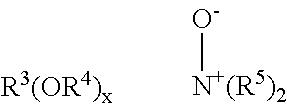Detergent and bleach compositions
a technology of detergent and composition, applied in detergent compositions, soap detergent compositions, chemistry apparatus and processes, etc., can solve the problems of dyeing of some coloured fabrics into the laundry wash solution, difficulty in removing staining, and high level of surfactant, and affect the stability of the host-guest complex. , the effect of reducing the stability of the complex
- Summary
- Abstract
- Description
- Claims
- Application Information
AI Technical Summary
Benefits of technology
Problems solved by technology
Method used
Image
Examples
examples
Abbreviations used in Examples
[0053] In the examples, the abbreviated component identifications have the following meanings: [0054] Carbonate: Anhydrous sodium carbonate [0055] STPP: Sodium tripolyphosphate [0056] Silicate: Amorphous Sodium Silicate (SiO2:Na2O=from 2:1 to 4:1) [0057] Percarbonate: Sodium percarbonate of the nominal formula 2Na2CO3.3H2O2 [0058] Amylase: α-amylase available from Novo Nordisk A / S [0059] Protease: protease available from Genencor [0060] SLF18: Poly-Tergent® available from BASF [0061] Alcosperse 240: sulfonated polymer available from Alco Chemical [0062] DPG: dipropylene glycol
[0063] In the following examples all levels are quoted as per cent (%) by weight.
[0064] Composition A (comprising the amount of host-guest complex aggregate particles indicated in A1) is introduced into a dual superposed compartment PVA rectangular base pouch. The dual compartment pouch is made from a Monosol M8630 film as supplied by Chris-Craft Industrial Products. 18 g of the...
PUM
| Property | Measurement | Unit |
|---|---|---|
| weight average particle size | aaaaa | aaaaa |
| density | aaaaa | aaaaa |
| melting point | aaaaa | aaaaa |
Abstract
Description
Claims
Application Information
 Login to View More
Login to View More - R&D
- Intellectual Property
- Life Sciences
- Materials
- Tech Scout
- Unparalleled Data Quality
- Higher Quality Content
- 60% Fewer Hallucinations
Browse by: Latest US Patents, China's latest patents, Technical Efficacy Thesaurus, Application Domain, Technology Topic, Popular Technical Reports.
© 2025 PatSnap. All rights reserved.Legal|Privacy policy|Modern Slavery Act Transparency Statement|Sitemap|About US| Contact US: help@patsnap.com


